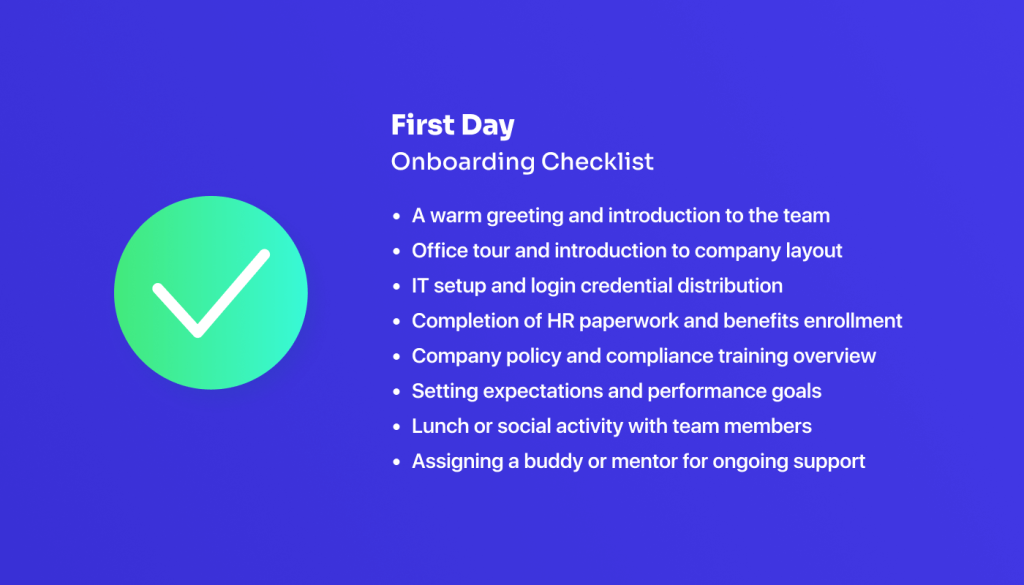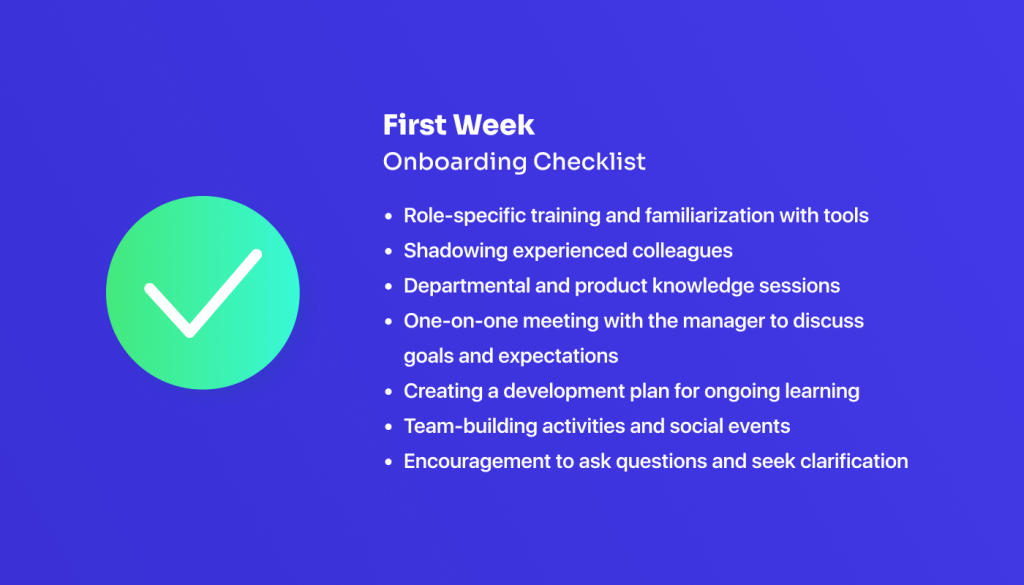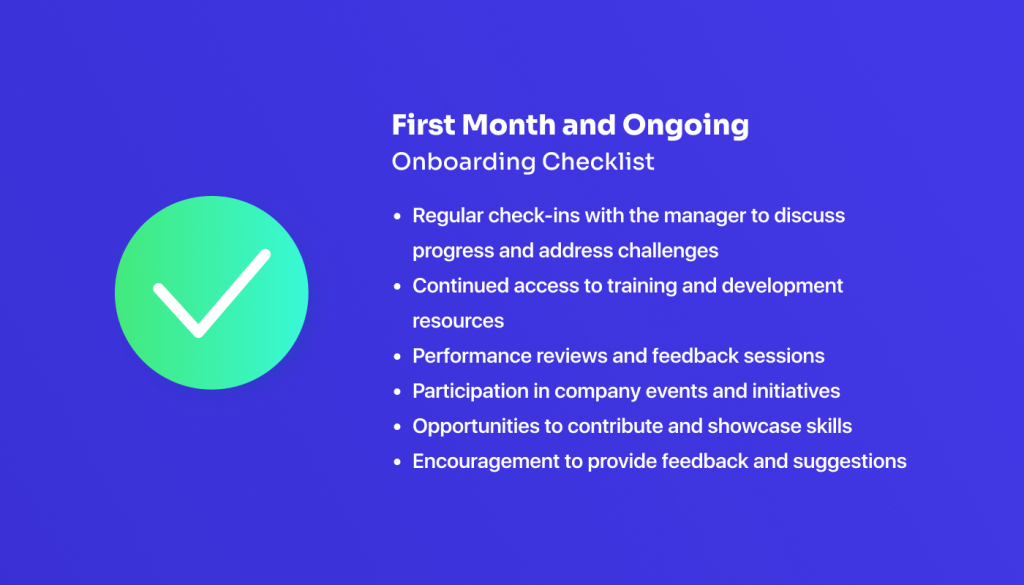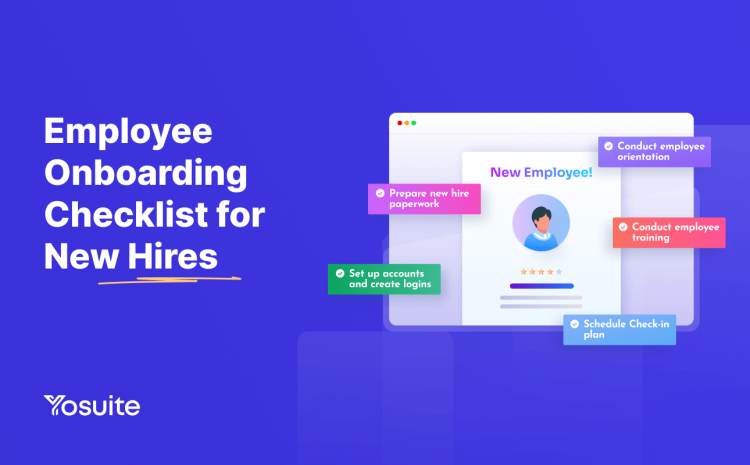Strategic onboarding activities in a company ensure a higher retention rate. Also, new hires can understand the company culture, adjust to their roles, and integrate seamlessly into the team.
I’ll provide a comprehensive employee onboarding checklist for each phase in this write-up. I’ll also discuss the key differences between the in-person and virtual onboarding process!
What is an Employee Onboarding Checklist?
An employee onboarding checklist is like a to-do list for welcoming new hires. It helps to integrate the new employee into the organization smoothly and covers all necessary steps.
Employee onboarding checklist includes preparing new hires’ workspace, introducing them to their team, and giving them an overview of the company, etc. Basically, it’s a way to make sure new employees feel welcomed and ready to hit the ground running!
You might be surprised: Effective onboarding can increase employee retention rates by up to 82% and enhance productivity by over 70%. So, having a proper employee onboarding checklist is a must!
Employee Onboarding Checklist for New Hires
Employee onboarding begins with the pre-arrival phase. Then comes the first day of orientation. The phases continue as first one week, one month, and beyond. In each phase, there are certain activities. These are broadly known as the employee onboarding checklist.
In this section, I’ve broken down each phase and provided the activity checklist to improve the employee onboarding system. Let’s get started.
Pre-Boarding (Before the First Day)
Pre-boarding is getting new hires ready before they start. It includes sending info, paperwork, office address (if in-person office), introduction with manager/team head, and other preparation details.
For this pre-arrival onboarding phase, both employer and employees need to take preparation. Here is the quick pre-onboarding checklist:
- Offering letter acceptance and background check completion
- Sending a welcome email with essential information:
- Company information and culture overview
- Benefits details and enrollment instructions
- Dress code and workplace expectations (if applicable)
- Pre-boarding tasks (e.g., online training modules)
- Workspace set-up with the necessary equipment and access
- Scheduling introductions and meetings with key personnel
- Preparation of HR paperwork and benefits enrollment
First Day: Orientation Checklist

Orientation is the first day that new employees begin their jobs. They meet their team, learn about the company, and get the rules.
Around 79% of employees find that onboarding programs help them fit in and integrate company culture better.
Also, the first day at a new job can be overwhelming. To ease the transition, organizations should implement comprehensive activities. These activities provide a structured guide for new employees. Also, helps them navigate tasks, introductions, and important information.
First-day orientation checklist for a new hire:
Welcome and Introductions
- A warm greeting and introduction to the team
- Office tour and introduction to company layout
- IT setup and login credential distribution
Administrative Tasks and Training
- Completion of HR paperwork and benefits enrollment
- Company policy and compliance training overview
- Setting expectations and performance goals
Integration and Team Building
- Lunch or social activity with team members
- Assigning a buddy or mentor for ongoing support
First Week Onboarding Checklist: Company Culture Immersion

Around 43% of employees reported their onboarding process lasting more than one day!
The first week at a new company is a crucial period for both employers and employees alike. It’s a time when initial impressions are formed, and relationships are established. And most importantly, new hires become acquainted with the organization’s culture in between this time.
To ensure a seamless integration into the company culture, organizations maintain a set of activities and evaluations.
In this section, you’ll find the first-week onboarding checklist tasks:
Continued Training and Development
- Role-specific training and familiarization with tools
- Shadowing experienced colleagues
- Departmental and product knowledge sessions
Performance Management and Goal Setting
- One-on-one meeting with the manager to discuss goals and expectations
- Creating a development plan for ongoing learning
Socialization and Integration
- Team-building activities and social events
- Encouragement to ask questions and seek clarification
First Month and Ongoing Checklist: Training and Development

The journey of onboarding doesn’t end after the first week. It’s an ongoing process that extends into the first month and beyond. In the initial 45 days, turnover rates for new employees can reach up to 20%.
Because, during this period, the company and employees both focus on continuous training and development.
Let’s explore the ongoing strategies and initiatives for onboarding an employee to grow gradually:
Ongoing Support and Development
- Regular check-ins with the manager to discuss progress and address challenges
- Continued access to training and development resources
- Performance reviews and feedback sessions
Building Relationships and Engagement
- Participation in company events and initiatives
- Opportunities to contribute and showcase skills
- Encouragement to provide feedback and suggestions
In-person vs. Virtual Onboarding Checklist: Key Differences
Traditionally, onboarding happens in person. However, with the rise of remote work, virtual onboarding has become more common. In this discussion, I’ll compare these two methods, highlighting their differences.
Communication Channels
- Primarily relies on digital tools like video calls, emails, and chat platforms.
- Requires clear communication guidelines to compensate for the absence of face-to-face interaction.
Onboarding Experience
- Offers flexibility but may lack in-person interaction.
- Relies on virtual orientation sessions and online resources to convey company culture.
Training Delivery
- Utilizes virtual training modules, webinars, and online resources for skill development.
- Requires self-directed learning and adaptability to navigate virtual environments effectively.
Technology Setup
- Coordination for remote technology setup such as onboarding HR software and access to necessary tools.
- Remote IT support is essential for troubleshooting technical issues.
Social Integration
- Involves intentional efforts to foster connections through virtual team activities and online chats.
- Encourages virtual coffee breaks and casual check-ins to replicate informal interactions.
In summary, in-person onboarding depends on physical presence and face-to-face interactions. On the other hand, virtual onboarding relies on digital communication tools, setting up a digital workspace, and creating virtual team bonding opportunities to provide a smooth transition for remote employees.
FAQs
Why is employee orientation important?
Employee orientation is vital for introducing new hires to the company culture, policies, and expectations, facilitating social integration, clarifying job roles, and boosting engagement and retention.
How to make your onboarding process effective?
For effective onboarding, prioritize clear communication, thorough training, mentorship, feedback, and ongoing process evaluation.
How to maintain industry-specific onboarding?
To maintain industry-specific onboarding, you should focus on providing training and resources relevant to industry standards, such as specialized programs, certifications, and mentorship.
How long should employee onboarding last?
Onboarding typically lasts anywhere from a few days to several months, to ensure new hires are fully acclimated and productive in their roles.
How to create an onboarding checklist?
For an effective onboarding checklist, incorporate pre-boarding tasks, orientation, training, paperwork, goal-setting, team-building, support, and ongoing improvements. Customize it for your organization and regularly review and update it.
Wrapping it up
Effective onboarding is crucial for new employee success. Here I’ve provided a comprehensive employee onboarding checklist. You can simply customize them based on your company’s niche, requirements, and culture.
So, invest time in crafting an onboarding program that reflects your values. You’ll see engaged, motivated, and productive employees as a result.



Leave a Reply